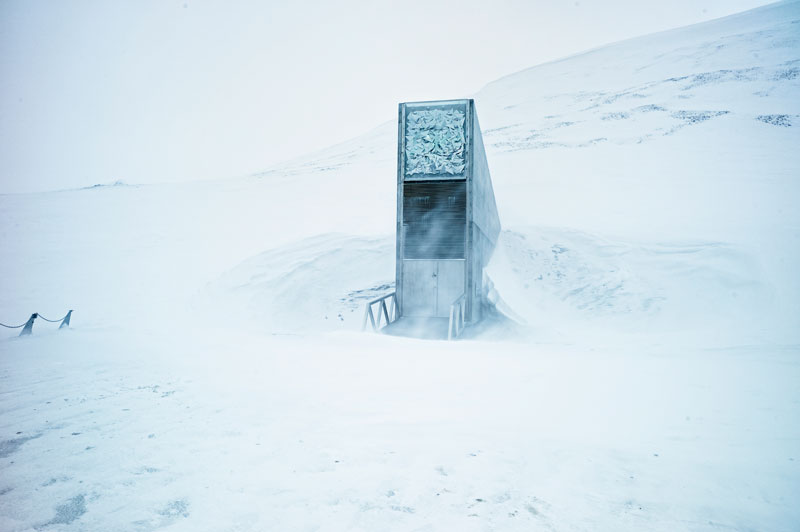
On 26 February 2008 the Svalbard Global Seed Vault officially opened. The seed bank is situated 120 meters (390 ft) inside a sandstone mountain on Norway’s Spitsbergen Island, about 1,300 km (810 mi) from the North Pole.
To date, there are an astonishing 864,309 seed varieties in the vault (approx. 1.5 million distinct seed samples of agricultural crops are thought to exist globally).
Spitsbergen was considered an ideal location because it lacks tectonic activity and has permafrost, which aids preservation. It is also 130 metres (430 ft) above sea level which means the site would remain dry even if the ice caps melted. The total area is 1000 square meters, but only the concrete entrance lobby is visible outside.
The vault is situated in permafrost at a constant 3-4 degrees Celsius below zero.
New seeds are carried into the vault, packed in crates each containing a maximum of 400 seed types. The crates are sealed by the gene bank which deposits the seeds. Each crate holds up to 400 seed samples, and a seed sample typically consists of around 500 seeds sealed in an airtight aluminium bag.
Svalbard Global Seed Vault has the capacity to store 4.5 million different seed types, and so it can hold duplicates of all the unique seed types currently existing in the many gene banks around the world, and will also be able to accommodate new seed types collected in the future.
The seeds are stored in four-ply sealed envelopes, then placed into plastic tote containers on metal shelving racks. The storage rooms are kept at −18 °C (−0.4 °F). The low temperature and limited access to oxygen will ensure low metabolic activity and delay seed aging.
The permafrost surrounding the facility will help maintain the low temperature of the seeds should the electricity supply fail.
The seed vault is managed under terms spelled out in a tripartite agreement between the Norwegian government, the Global Crop Diversity Trust (GCDT) and the Nordic Genetic Resource Center (NordGen).
The seed vault functions like a safe deposit box in a bank. The bank owns the building and the depositor owns the contents of his or her box. The Government of Norway owns the facility and the depositing genebanks own the seeds they send.
Primary funding for the Trust comes from such organisations as the Bill & Melinda Gates Foundation and from various governments worldwide.
In Norway, government-funded construction projects exceeding a certain cost must include artwork. The artwork; “Perpetual Repercussion” by Dyveke Sanne adorns the building’s roof and upper façade front at the entrance.
The artwork renders the building visible from far off both day and night, using highly reflective stainless steel triangles of various sizes. Combined with refractive elements such as mirrors and prisms, the triangles at the entrance catch and reflect light and sunlight. The appearance changes with the time of day as well as the season.
The Crop Trust has worked with over 100 countries worldwide to conserve crop diversity. In 2008, the Svalbard Global Seed Vault was ranked no. 6 on Time’s Best Inventions of the Year.
Sources
– The Svalbard Global Seed Vault Official Website
– The Crop Trust
– Wikipedia: Svalbard Global Seed Vault
– Flickr: Svalbard Globale frøhvelv